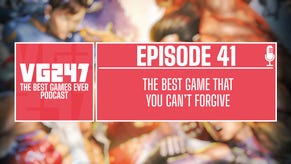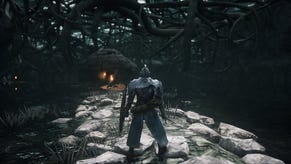Deciphering Dark Souls 2's 'accessibility'
Dark Souls 2's very existence has Stace Harman rather delighted, but he questions whether making the game more accessible might rob it of its appeal.
There are many stories that offer an insight into the mind of Hidetaka Miyazaki, the creative driving force behind Demon’s Souls and Dark Souls. There’s one about a digital photo frame that displayed varied feedback to Demon’s Souls, which the director kept on his desk throughout the development of its follow-up.
There’s another about Miyazaki watching tapes of dedicated Demon’s Souls players completing the game with the weakest character class, so that he might better understand the level of devotion that the game was capable of inspiring.
My personal favourite tells of how the air of ambiguity that surrounds series features like World Tendency and Covenants is a considered and deliberate choice on Miyazaki’s part.
It is the director’s attempt to recreate the mix of awe and incomprehension that he himself experienced during childhood as he struggled to understand the foreign language of western fantasy literature.
By not providing all of the answers and leaving some mysteries unexplained, Miyazaki hoped to encourage players to invest themselves in the fiction of his Souls series and to engage their imagination to fill in the blanks.
It’s these stories that go some way to helping us understand what Miyazaki has brought to From Software’s celebrated series, in terms of both mechanical design and emotional impact. It’s these same stories that make it difficult for fans to not be concerned by the fact that Miyazaki’s involvement in Dark Souls 2 is at a supervisory level only.
What’s more, his replacement, Tomohiro Shibuya, has stated that Dark Souls 2 will be less obtuse and easier to understand, while on a recent trip to Namco Bandai’s UK HQ I was told that the game’s narrative will be clearer and its story more structured.
Of course, there’s nothing inherently wrong with wanting to make something easier to understand and many will feel that the secrets of series should, at the very least, be decipherable through exploration of the game, rather than an online wiki. However, all of this makes me wary of the direction that Dark Souls 2 could take if pursuit of these notions is not expertly managed.
A more structured story suggests a clearer idea of where to go and what to do next, which risks depriving players of having to make their own exploratory journeys to figure it out for themselves. To be denied this joy because a wider audience might be disorientated by too many paths or frustrated by the lack of obvious direction is one of my biggest fears for Dark Souls 2.
Say what you see
Watching a Namco Bandai rep playing 20-minutes of the sequel cannot hope to address these concerns but it does reveal a number of clues concerning other key elements of the game.
The gameplay that we’re shown is that which was revealed last month, so rather than give a blow-by-blow account of it it’s more useful to focus on some of the finer details. In this vertical slice of gameplay, an armoured knight is depicted entering a ruined keep, lighting a bonfire and descending a ladder into the depths below.
The bonfires are amongst a number of features to make a return from Dark Souls. In this pre-alpha gameplay there’s much that is yet to be pinned down, but nonetheless the basic form and function of the HUD appears familiar. The health and stamina bars are the same as before, although there’s what appears to be a sun and moon icon where the humanity counter was previously.
There’s no word on whether this is indicative of a shifting day/night cycle, although it doesn’t appear to be the case from what I observe. It could be an emblem that depicts covenant allegiance or is linked to the character class; similarly, it might just be a placeholder at this point. Humanity was one of the core concepts of Dark Souls, affecting numerous game factors and so it wouldn’t be surprising for it to feature in the sequel in one form or another.
The HUD in the bottom-left of the screen looks largely familiar. One key difference is the ability to assign three weapons to the right-hand weapon-slot compared to Dark Souls' two. There are also smaller item slots next to the main cardinal-point display that suggest an expanded number of secondary items will be accessible without having to dip into the inventory system.
The inventory system itself is currently implemented in only its most basic form. It still takes up most of the screen but is offset to give you a view of your character. While this affords a vanity view of your avatar as you swap armour and equipment it has the more important function of allowing you to see if you’re about to be attacked; it’s unknown at this stage whether you’re able to pause the game.
Aesthetically, Dark Souls 2 shares the ruined beauty of its predecessors. The art direction once again lends personality to crumbling grandiose structures and harsh natural landscapes. A new engine has been developed in order to address the frame rate issues of Dark Souls and with the new engine come a handful of new tricks. The lighting effects are excellent and also serve a gameplay function.
It’s now possible to carry a torch to illuminate those dark corners but doing so deprives you of the ability to equip a shield and so it may be a case of sacrificing the ability to effectively defend against that which is trying to kill you for the relative luxury of being able to see it.
Outside, wind rustles clothing and, in one dangerous sequence, slows movement across a bridge to a crawl as dragons circle overhead. It looks likely that we’ll see more varied weather conditions that we have before.
In truth, there is nothing on show here that offers any cause for alarm. No wholesale changes, recharging health or ill-advised cover mechanics to sully the series’ pure roots and challenging gameplay.
Instead, there is just that one nagging worry that without Miyazaki’s constant presence, the rest of the team might be tempted to tip the balance further in the player’s favour or face publisher pressure to chase a bigger audience by relaxing the firm hand that the first two titles maintained throughout.
Perhaps it’s unfair to be concerned or maybe it’s the unavoidable by-product being so invested in the franchise. I keep coming back to the idea that Miyazaki’s show-not-tell approach is completely at odds with so many other high-profile titles. Without him, will damaging sacrifices be made in a bid for mass-market acceptance?
Of course, neither Dark Souls nor Demon’s Souls were made by just one man. Therefore, I can only hope that those who worked alongside Miyazaki paid close attention to his methods and share his passion for treating players like intelligent adults. Ultimately, I want some of the mystery to remain intact so that I might savour the experience of figuring it out for myself.
Dark Souls 2 will be released on PS3, 360 and PC either later this year or early next.












